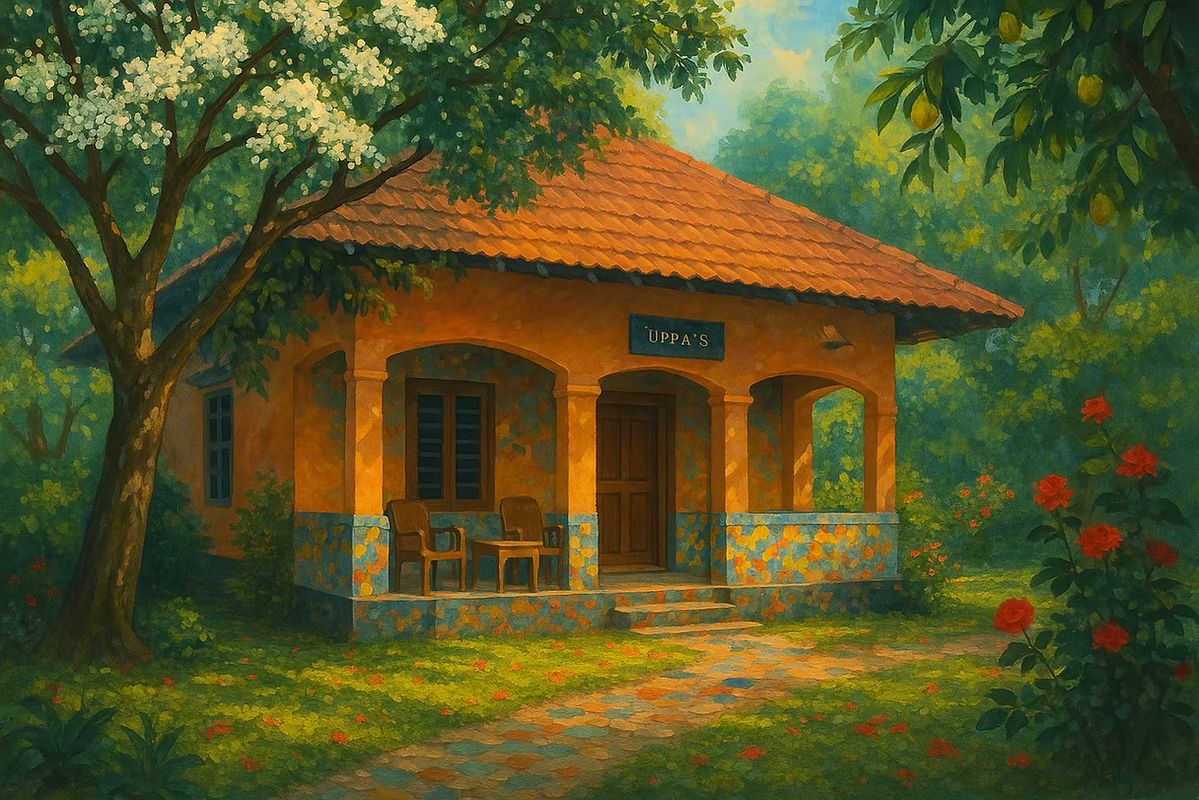Uppa’s home was the definition of what makes a house, home. It was my mother’s house where we as kids spent days and nights together; when being together was the normal and not any luxury to look forward to. The pebbled courtyard was surrounded by trees and a well-maintained garden with a lawn at one end. It was a sight watching the fully bloomed white jamun tree. We used to climb the tree despite the torturous ants. The mango trees were the abode of birds. Most of the trees were homes for us. Homes within a home.
On the front wall was a dark blue name plate with Uppa’s name and house name sticking out in white coloured plastic letters. One of my biggest ambitions as a kid was to be tall enough to reach and touch those letters. The front portion of the house had its walls and floor adorned with mosaics of different colours. Plastic chairs were laid on both sides of a teapoy on which Uppa and Umma used to sit and read newspapers and magazines. We often sat on the cool floor and shared stories filled with laughter. Time and again, a gentle breeze would blow, rustling the leaves of the mango trees and at times, scattering the petals of roses in the front yard. A bird had built her nest in this front veranda over the light bulb. Once, she flew inside into the hall and fluttered about Uppa, who was watching TV.
Lying on the mosaiced floor of the hall, I used to marvel at the bright and vibrant colours of the mosaic. It seemed like someone had quite artistically scattered different colours from a palette onto the floor. The hall, however was not the central portion of the house. It was my grandparents’ bedroom around which the whole house had been built. That bedroom with a line of windows opening to the dining hall was dark even on bright sunny days, and we were quite scared to go inside it. But the room was the safest abode on dark, rainy, thunderous nights when lightning struck the ground. We could huddle together inside it and feel safe and warm. It had two beds, a big almirah and a small shelf filled with numerous articles from medicine to money. Umma had kept her Surf Excel container filled with savings inside the shelf.
A long table and chairs occupied almost the entirety of the dining hall. The table was covered with a plastic spread filled with bright pictures of fruits. On the left end of the dining hall was a small room which we called kochu muri. It had a black, cool floor on which my mother and her sisters used to sleep in a “square” when they were kids. Often, someone would stamp the head of the person adjacent to her. It was also the room where they spent their days after delivery. Time after time, a cloth cradle was spotted in the room which smelt of baby products. We all, in a sense, grew in that room.
On the right end of the dining room was the kitchen. The kitchen was predominantly Umma’s space. It always exuded the aromas of either Umma’s curries, payasam, neyyappams or jackfruit jam. Next to the kitchen was a small space which we called koni muri, owing to the presence of a wooden ladder- a koni or eni- that reached the attic. The koni muri had a wooden table with many drawers in which clothes were neatly kept. There was a mirror on top of the table and two small drawers on its sides where we could keep kajal. We used to call the table kannadi mesha (table with a mirror). The reflection on the mirror always looked beautiful due to the lighting in the koni muri. From this room, one could access my grandparents’ bedroom and cross through the hall, dining room and kitchen to reach back in the koni muri again.
The wooden ladder in the room led to the attic or thattumpuram. It was a room straight from the folklores. A yellow bulb illumined the attic, which complemented the aura of antiquity. The attic had two small doors opening respectively to the front and back portions of the house. There was a large wooden storage box with three compartments at the far end. The attic was home to a number of articles- the aluminium boxes which my mother and aunts carried to school, large utensils and vessels, unused plates and tumblers which were presented as wedding gifts, stacks of old newspapers and magazines, to name a few. Stepping inside the attic was equivalent to entering a whole different world from the past. The past came to life in the attic. Sitting on the attic floor, we told each other scary tales and slipped downstairs quietly, frightened.
I would like to believe that the house knew even the sounds of our footsteps. Each corner was filled with our chatter and laughter. Entering the house felt like seeking comfort in the warm embrace of someone dear. If the walls could talk, they would have beseeched us to stay longer, to stay closer, to truly live the moment. It was a house that never ceased to be a home. A home that continues to live in the memories of people who once inhabited it. An embodiment of the word, home.
On the front wall was a dark blue name plate with Uppa’s name and house name sticking out in white coloured plastic letters. One of my biggest ambitions as a kid was to be tall enough to reach and touch those letters. The front portion of the house had its walls and floor adorned with mosaics of different colours. Plastic chairs were laid on both sides of a teapoy on which Uppa and Umma used to sit and read newspapers and magazines. We often sat on the cool floor and shared stories filled with laughter. Time and again, a gentle breeze would blow, rustling the leaves of the mango trees and at times, scattering the petals of roses in the front yard. A bird had built her nest in this front veranda over the light bulb. Once, she flew inside into the hall and fluttered about Uppa, who was watching TV.
Lying on the mosaiced floor of the hall, I used to marvel at the bright and vibrant colours of the mosaic. It seemed like someone had quite artistically scattered different colours from a palette onto the floor. The hall, however was not the central portion of the house. It was my grandparents’ bedroom around which the whole house had been built. That bedroom with a line of windows opening to the dining hall was dark even on bright sunny days, and we were quite scared to go inside it. But the room was the safest abode on dark, rainy, thunderous nights when lightning struck the ground. We could huddle together inside it and feel safe and warm. It had two beds, a big almirah and a small shelf filled with numerous articles from medicine to money. Umma had kept her Surf Excel container filled with savings inside the shelf.
A long table and chairs occupied almost the entirety of the dining hall. The table was covered with a plastic spread filled with bright pictures of fruits. On the left end of the dining hall was a small room which we called kochu muri. It had a black, cool floor on which my mother and her sisters used to sleep in a “square” when they were kids. Often, someone would stamp the head of the person adjacent to her. It was also the room where they spent their days after delivery. Time after time, a cloth cradle was spotted in the room which smelt of baby products. We all, in a sense, grew in that room.
On the right end of the dining room was the kitchen. The kitchen was predominantly Umma’s space. It always exuded the aromas of either Umma’s curries, payasam, neyyappams or jackfruit jam. Next to the kitchen was a small space which we called koni muri, owing to the presence of a wooden ladder- a koni or eni- that reached the attic. The koni muri had a wooden table with many drawers in which clothes were neatly kept. There was a mirror on top of the table and two small drawers on its sides where we could keep kajal. We used to call the table kannadi mesha (table with a mirror). The reflection on the mirror always looked beautiful due to the lighting in the koni muri. From this room, one could access my grandparents’ bedroom and cross through the hall, dining room and kitchen to reach back in the koni muri again.
The wooden ladder in the room led to the attic or thattumpuram. It was a room straight from the folklores. A yellow bulb illumined the attic, which complemented the aura of antiquity. The attic had two small doors opening respectively to the front and back portions of the house. There was a large wooden storage box with three compartments at the far end. The attic was home to a number of articles- the aluminium boxes which my mother and aunts carried to school, large utensils and vessels, unused plates and tumblers which were presented as wedding gifts, stacks of old newspapers and magazines, to name a few. Stepping inside the attic was equivalent to entering a whole different world from the past. The past came to life in the attic. Sitting on the attic floor, we told each other scary tales and slipped downstairs quietly, frightened.
I would like to believe that the house knew even the sounds of our footsteps. Each corner was filled with our chatter and laughter. Entering the house felt like seeking comfort in the warm embrace of someone dear. If the walls could talk, they would have beseeched us to stay longer, to stay closer, to truly live the moment. It was a house that never ceased to be a home. A home that continues to live in the memories of people who once inhabited it. An embodiment of the word, home.

